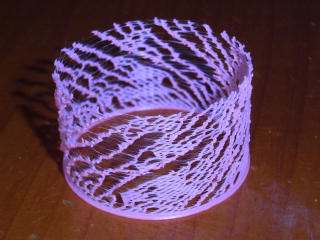Self-organized 3D-printing Patterns Simulated by Cellular Automata
Kanada, Y., 20th International Workshop on Cellular Automata and Discrete Complex Systems (Automata 2014), July 2014.
[ 日本語のページ ]
[ Paper PDF file ]
[ Paper PDF file (extended ver. for IWNC8 book) ]
[ Slides (reduced size) ]
[ Slides (with a movie, Keynote) ]
[ Printing process (YouTube) ]
 Abstract: 3D printers are usually used for printing objects designed
by 3D CAD exactly, i.e., deterministically. However, 3D printing process
contains stochastic self-organization process that generate emergent
patterns. A method for generating fully self-organized patterns using a
fused deposition modeling (FDM) 3D printer has been developed. Melted
plastic filament is extruded constantly in this method; however, by using
this method, various patterns, such as stripes, splitting and/or merging
patterns, and meshes can be generated. A cellular-automata-based
computational model that can simulate such patterns have also been
developed.
Abstract: 3D printers are usually used for printing objects designed
by 3D CAD exactly, i.e., deterministically. However, 3D printing process
contains stochastic self-organization process that generate emergent
patterns. A method for generating fully self-organized patterns using a
fused deposition modeling (FDM) 3D printer has been developed. Melted
plastic filament is extruded constantly in this method; however, by using
this method, various patterns, such as stripes, splitting and/or merging
patterns, and meshes can be generated. A cellular-automata-based
computational model that can simulate such patterns have also been
developed.
Introduction to this research theme: 3D shape formation technologies
